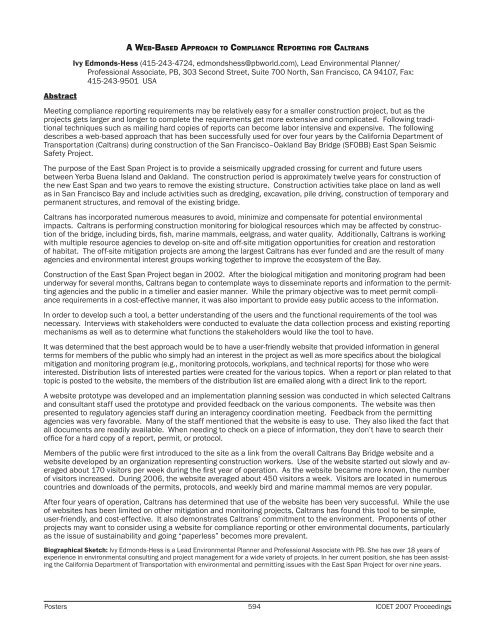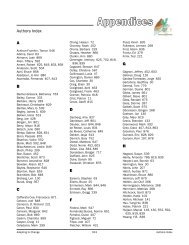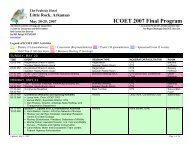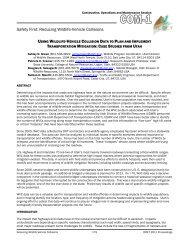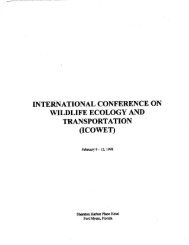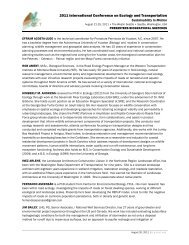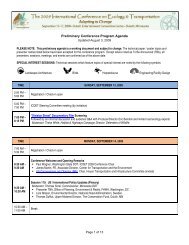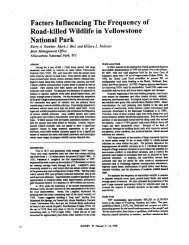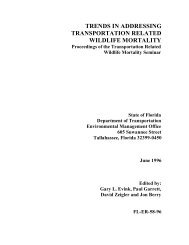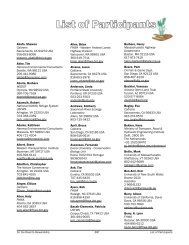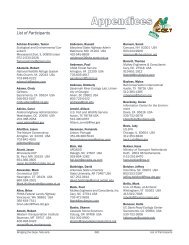Poster Sessions, pages 567-640 - ICOET
Poster Sessions, pages 567-640 - ICOET
Poster Sessions, pages 567-640 - ICOET
Create successful ePaper yourself
Turn your PDF publications into a flip-book with our unique Google optimized e-Paper software.
Abstract<br />
A Web-Based Approach to Compliance Reporting for Caltrans<br />
Ivy Edmonds-Hess (415-243-4724, edmondshess@pbworld.com), Lead Environmental Planner/<br />
Professional Associate, PB, 303 Second Street, Suite 700 North, San Francisco, CA 94107, Fax:<br />
415-243-9501 USA<br />
Meeting compliance reporting requirements may be relatively easy for a smaller construction project, but as the<br />
projects gets larger and longer to complete the requirements get more extensive and complicated. Following traditional<br />
techniques such as mailing hard copies of reports can become labor intensive and expensive. The following<br />
describes a web-based approach that has been successfully used for over four years by the California Department of<br />
Transportation (Caltrans) during construction of the San Francisco–Oakland Bay Bridge (SFOBB) East Span Seismic<br />
Safety Project.<br />
The purpose of the East Span Project is to provide a seismically upgraded crossing for current and future users<br />
between Yerba Buena Island and Oakland. The construction period is approximately twelve years for construction of<br />
the new East Span and two years to remove the existing structure. Construction activities take place on land as well<br />
as in San Francisco Bay and include activities such as dredging, excavation, pile driving, construction of temporary and<br />
permanent structures, and removal of the existing bridge.<br />
Caltrans has incorporated numerous measures to avoid, minimize and compensate for potential environmental<br />
impacts. Caltrans is performing construction monitoring for biological resources which may be affected by construction<br />
of the bridge, including birds, fish, marine mammals, eelgrass, and water quality. Additionally, Caltrans is working<br />
with multiple resource agencies to develop on-site and off-site mitigation opportunities for creation and restoration<br />
of habitat. The off-site mitigation projects are among the largest Caltrans has ever funded and are the result of many<br />
agencies and environmental interest groups working together to improve the ecosystem of the Bay.<br />
Construction of the East Span Project began in 2002. After the biological mitigation and monitoring program had been<br />
underway for several months, Caltrans began to contemplate ways to disseminate reports and information to the permitting<br />
agencies and the public in a timelier and easier manner. While the primary objective was to meet permit compliance<br />
requirements in a cost-effective manner, it was also important to provide easy public access to the information.<br />
In order to develop such a tool, a better understanding of the users and the functional requirements of the tool was<br />
necessary. Interviews with stakeholders were conducted to evaluate the data collection process and existing reporting<br />
mechanisms as well as to determine what functions the stakeholders would like the tool to have.<br />
It was determined that the best approach would be to have a user-friendly website that provided information in general<br />
terms for members of the public who simply had an interest in the project as well as more specifics about the biological<br />
mitigation and monitoring program (e.g., monitoring protocols, workplans, and technical reports) for those who were<br />
interested. Distribution lists of interested parties were created for the various topics. When a report or plan related to that<br />
topic is posted to the website, the members of the distribution list are emailed along with a direct link to the report.<br />
A website prototype was developed and an implementation planning session was conducted in which selected Caltrans<br />
and consultant staff used the prototype and provided feedback on the various components. The website was then<br />
presented to regulatory agencies staff during an interagency coordination meeting. Feedback from the permitting<br />
agencies was very favorable. Many of the staff mentioned that the website is easy to use. They also liked the fact that<br />
all documents are readily available. When needing to check on a piece of information, they don’t have to search their<br />
office for a hard copy of a report, permit, or protocol.<br />
Members of the public were first introduced to the site as a link from the overall Caltrans Bay Bridge website and a<br />
website developed by an organization representing construction workers. Use of the website started out slowly and averaged<br />
about 170 visitors per week during the first year of operation. As the website became more known, the number<br />
of visitors increased. During 2006, the website averaged about 450 visitors a week. Visitors are located in numerous<br />
countries and downloads of the permits, protocols, and weekly bird and marine mammal memos are very popular.<br />
After four years of operation, Caltrans has determined that use of the website has been very successful. While the use<br />
of websites has been limited on other mitigation and monitoring projects, Caltrans has found this tool to be simple,<br />
user-friendly, and cost-effective. It also demonstrates Caltrans’ commitment to the environment. Proponents of other<br />
projects may want to consider using a website for compliance reporting or other environmental documents, particularly<br />
as the issue of sustainability and going “paperless” becomes more prevalent.<br />
Biographical Sketch: Ivy Edmonds-Hess is a Lead Environmental Planner and Professional Associate with PB. She has over 18 years of<br />
experience in environmental consulting and project management for a wide variety of projects. In her current position, she has been assisting<br />
the California Department of Transportation with environmental and permitting issues with the East Span Project for over nine years.<br />
<strong>Poster</strong>s 594 <strong>ICOET</strong> 2007 Proceedings


